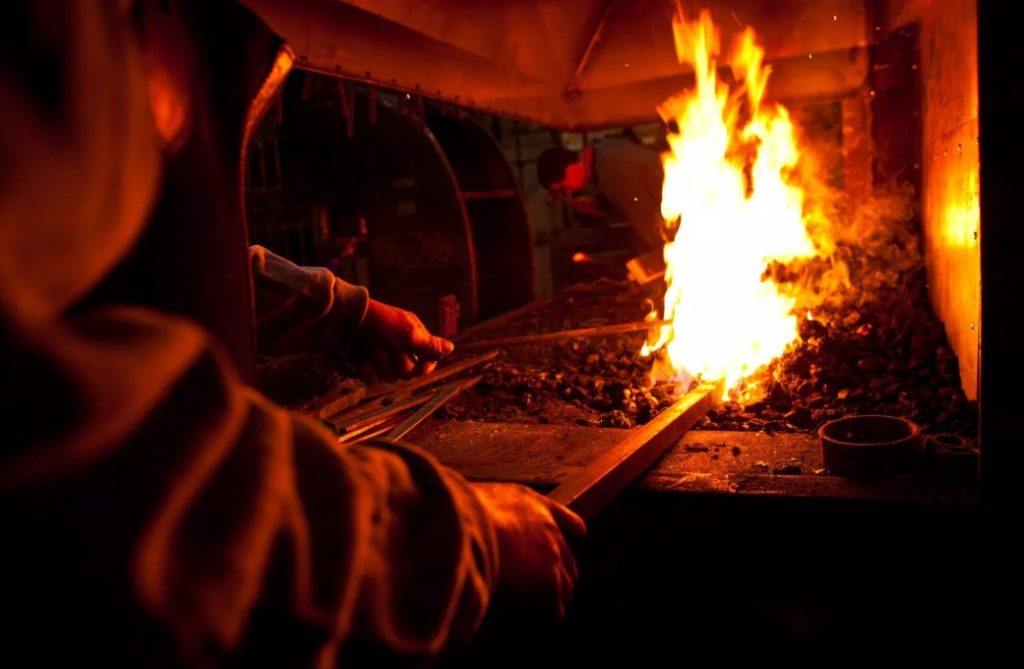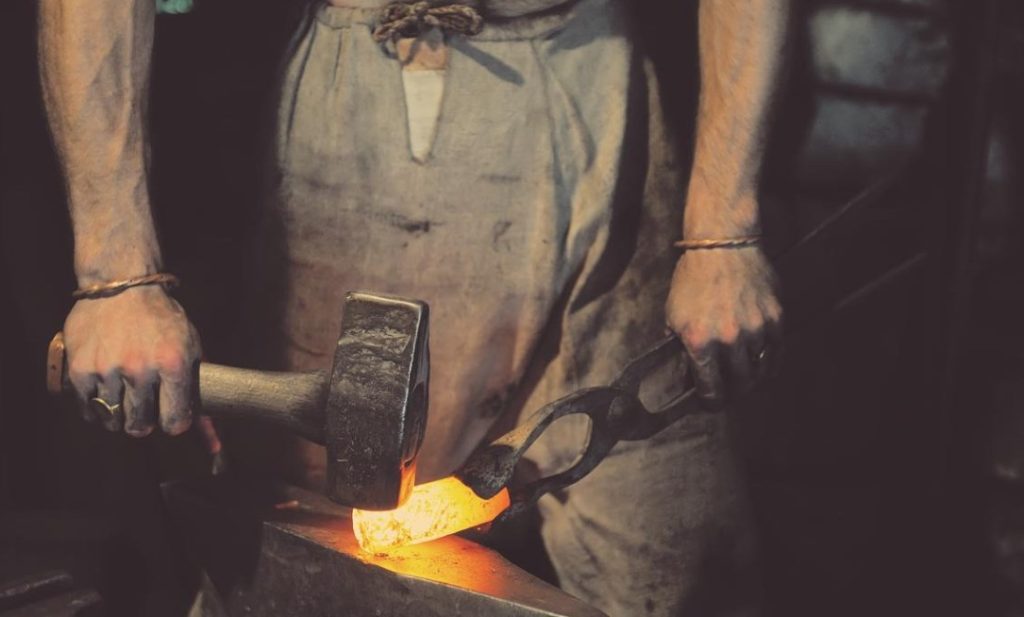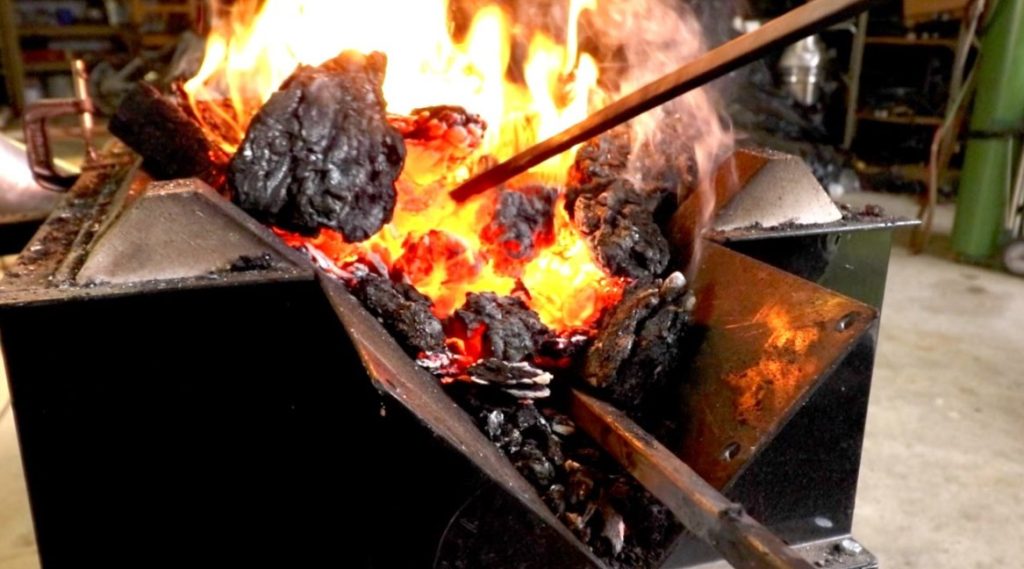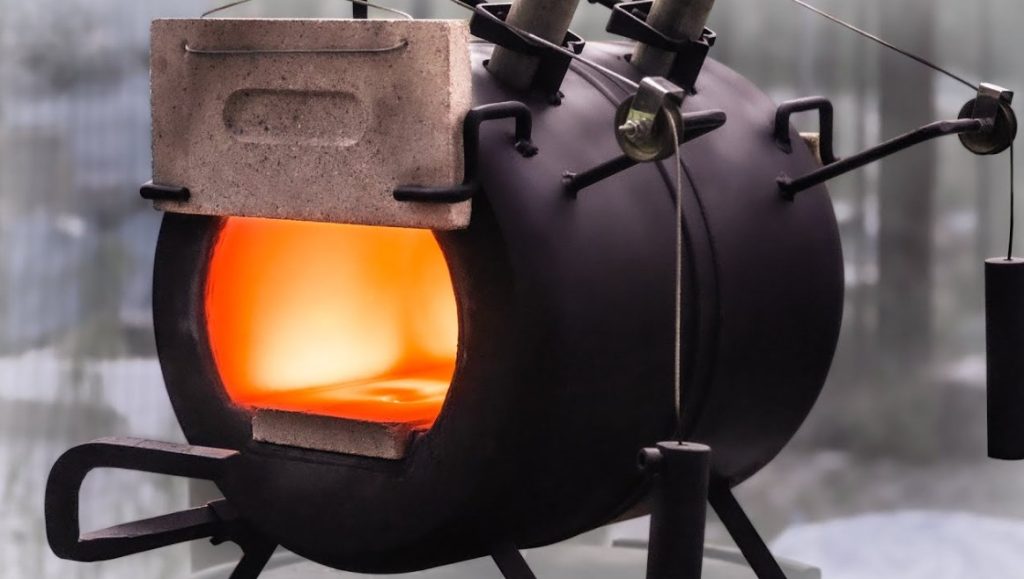Blacksmithing has existed for a long time. Even while blacksmithing may not be as necessary today as it once was, more and more people are becoming novice blacksmiths. The price of a blacksmithing shop, tools, materials, fuels, etc. is a concern shared by the majority of those people.
Does a blacksmithing forge really cost that much? Everything relies on the kind of work you intend to accomplish and the additional tools you’ll need for it. Let’s begin.

Contents
Is blacksmithing an expensive hobby?
There are many pricey hobbies available. The excellent thing is that learning blacksmithing doesn’t have to be so pricey if you’ve ever thought about doing it. High-end forges and apparatus may easily set you back several hundred dollars or perhaps more, but that doesn’t have to be the case.
Depending on how advanced you want to go, blacksmithing may be a cheap or expensive pastime. Beginner blacksmiths might just need to spend $200 to $500, however advanced blacksmithing might cost several thousand dollars.
What aspects affect the price of blacksmithing?
Blacksmithing costs can vary greatly, as we have already stated. For instance, novice blacksmiths who merely want to create modest and straightforward projects could only require a few fundamental tools.
On the other end of the range, someone who wants to make Damascus knives will have to invest a lot of money in a power hammer or press.
Let’s now look more closely at what drives these prices in general.

Construction of workshops
You may have guessed it by now. The blacksmith needs a place to work where they can do their tasks. I’ll interchange the phrases “smithy” and “blacksmith’s workshop” for the remainder of the essay.
If your workshop is already built and doesn’t need any construction work, your cost is nothing. On the other side, the price changes greatly if you have room, but it also needs construction work.
The costs could include building walls and floors, insulating the shop, as well as other things. You’ll notice that it is quite difficult to even estimate a price.
Finally, the cost will rely on the cost of your rental fee if you don’t already have a space of your own.
Tools and machinery
As a blacksmith, you must have the proper tools and equipment to turn your thoughts into a final product. It makes no difference if you are a novice or an expert blacksmith. You are limited to daydreaming about forging without them.
The most expensive expenses in this craft are typically the tools and equipment used in blacksmithing. Since you don’t need any specialized tools in the beginning, a beginner doesn’t have to spend a lot of money on tools. For more complex jobs, a smith will likely require more specialized tools as he continues to improve.
In general, there are two types of tools: manual and power tools. Since hand tools are typically far less expensive than power tools, beginning blacksmiths use them much more frequently. The two most costly instruments that are necessary are the anvil and the forge.
Common tools
A hammer, tongs, vice, chisels, punches, drifts, and fullers are further common hand tools. Power tools cost more; therefore you won’t see every beginner using them. Examples include a power hammer, hydraulic press, various types of grinders, and drill presses.
Don’t forget to take safety precautions as well. Blacksmithing involves forging a burning piece of metal, so appropriate safety measures must be taken.
This is why it’s important to use safety equipment while blacksmithing, like safety glasses, earplugs, and appropriate clothing. Our advice for beginning smiths is to make it a habit to put on safety glasses as soon as they arrive at the shop.
Every professional blacksmith uses protective gear and takes the appropriate safety measures while working. Unfortunately, a lot of blacksmiths have hearing problems. They’d probably admit to you that wearing ear protection would have been the only way this could’ve been prevented.
What is a blacksmithing forge?
A blacksmith utilizes a special kind of furnace called a “blacksmithing forge” to heat and forge metal into tools, objects, and other things. To get metals to a temperature that allows them to be easily manipulated and shaped, it is commonly a basin with a source of heat and an oxygen supply. They can be useful for forge welding as well.

The way a blacksmithing forge operates
The classic forge used in blacksmithing combines flowing air, fuel, and fire. The blacksmith lights solid fuel inside the hearth while the forge is in use. An air source that moves adds more oxygen to the flames.
Historically, this would have been accomplished with huge bellows. Forges today use fans. The tuyere, a pipe on the forge, is where oxygen enters the forge. The oxygen makes the fire hotter and enables the forge to burn more intensely. It must reach a temperature where metal is easier to work with or where hardening stops happening.
Modern indoor forges frequently use a chimney and vent to direct smoke outside of the blacksmith shop. In a conventional forge, a blacksmith must constantly balance the air and fuel as they are operating.
How do a blacksmithing forge, furnace, and foundry vary from one another?
Even though these phrases are sometimes used interchangeably, they all have quite different purposes when it comes to heating metals. Metals are melted in specific furnaces at a foundry before being cast into molds.
In a forge, metals are heated in a furnace or hearth before being hammered into shape. Metal is heated and shaped by pounding in forging.

What is the price of a forge?
Types of forges
Before you begin looking for forges, you should be familiar with each type and how they work. Coal and gas are the two main fuel sources for forges.
Here is a description of each kind of forge, along with a list of its benefits and drawbacks.
Coal forge
The solid fuel forge, also called a coal forge, has been in use for many years and can handle both coal and charcoal.
There are a variety of factors why blacksmiths have switched to propane forges, even though it has been used for so long and is obviously a reliable technology preferred by many.

Advantages of a coal forge
1. DIY projects can be done with this type of forge. Because they don’t require a large expense to manufacture, they are excellent for novices.
2. It is simple for them to achieve high temperatures. You can forge and weld any metal since coal can achieve temperatures of over 3,000 degrees Fahrenheit with enough air supply.
3. The cost of running them may be low. Coal is a reasonably priced choice and can be purchased for $10.

Problems with these forges
1. Coal burning is untidy. If you undertake blacksmithing in your backyard, the smoke from the burning coal may be unhealthy to breathe and bothersome to your neighbors.
2. The fire needs to be kept up all the time. You must watch out that the fire doesn’t go out or become too hot. Although many blacksmiths view this as a benefit because it provides them greater control, a novice may find it inconvenient.
3. They frequently occupy a lot of room and aren’t transportable. You will require a sizable amount of area for the forge and fuel supply if you choose the solid fuel forge. It will need some cleaning and disassembling before you’re able to pack it up if you want to take it with you.
Gas forge
For suburban blacksmiths, a gas forge is typically a preferable choice. It is simpler to put together and burns much cleaner than the previous type. However, it does have drawbacks.
Advantages of gas forges
1. They burn thoroughly. You will not have to cope with offensive smoke as the propane burns, so you won’t have to irritate your neighbors or run the risk of damaging your lungs.
2. Gas forges are portable and compact. They are light and compact, making them simple to transport from one location to another. It might be assembled in your basement and moved as needed.
3. The heat maintains a steady temperature. Because you can concentrate on techniques rather than the heat, this feature is fantastic for novices.
The drawbacks of a gas-powered forge
1. Some gas forges make noise. Depending on the gas forge you purchase, you might not have to worry about smoke, but you might have to cope with noise.
2. Some gas forges cannot heat up sufficiently to melt metals together. Metals can be molded into new shapes, yet welding metal together may not be possible.
3. Propane is not always cheap. Although the cost of propane varies considerably, a bag of coal is often more expensive. Depending on how frequently you plan to use the forge, propane may get very pricey.
4. If you apply borax flux, the forge’s base may erode.

How much do forges cost?
Almost nothing can be forged without a source of heat for the metal. It is used by blacksmiths to heat metal to the proper forging temperature. Its construction can be either straightforward or quite complex.
Forges used in blacksmithing require two things: a lot of air and fuel of some sort. To start and keep a fire, as well as to control it, you need fuel. Depending on the fuel you intend to utilize, you can now select from a gas forge, coal forge, or electric forge.
You can now think about costs after determining the kind of forge that will work finest for you. Depending on the source you choose, you may pay little or a lot.
In general, investing more money will result in a higher-quality item that will serve you well for a long time. A less expensive alternative can be the best for you if you’re a newbie, considering blacksmithing for the first time.
Nevertheless, if you get a poor-quality forge, you could have a bad experience that causes you to lose interest in the craft.
The preferred fuel type has a significant impact on the forge’s price. Coal forges often cost $200 to $1500, while those made of propane typically cost $150 to $1000.
The price range for a quality heat-treatment forge, however, ranges from $500 to $10,000. Everything relies on the level of expertise and the nature of the projects.
On the contrary, you could pass if you merely wanted a DIY forge for about $50.

Homemade coal forge
Typically, coal forges are the simplest to construct for beginner blacksmiths. They may be the least expensive as a result.
Here is the basic minimum you need to locate or purchase for a do-it-yourself forge:
- an object made of solid steel, such as the deck of a lawnmower or a charcoal grill
- non-galvanized black piping to guide your airflow
- grating to prevent coal from slipping into the pipe
- a blower of some kind (this can be an exhaust fan or a hair dryer; leaf blower is not something we advise because they are typically overly powerful)
- coal

Additional blacksmithing tools
Your forge’s fuel
Cost: $20-$50
You will need to invest money in anything to fuel the fire in your forge, whether it be coals or propane. Fortunately, you won’t be spending a lot of money here.
If you happen to have a used propane tank lying around, you may fill it up or trade it in for a pre-filled one at a gas station for about $20. If not, the cost of a tank of gas will probably be closer to $50.
Similar amounts are spent on coal. Depending on the coal brand you purchase, a 50-pound bag may cost you somewhere between $30 to $50.
Generally, though, it shouldn’t be that expensive for you, and depending on how often you use your forge, one bag of coal or propane tank may last you months.

Safety equipment
Cost: $20-$60
When working on your craft, it’s crucial to wear safety gear, especially if you’re a novice blacksmith seeking to start at home. While it may be appealing to only give it a try without paying attention to basic safety, if a spark flies right into your eye, it may potentially backfire on you.
The first, and possibly most crucial, step is to wear glasses while working. Anything will do; they don’t have to be fancy. If necessary, just a pair of swimming goggles can do the trick; if you know where to search, you can find these for $5 to $10 per pair.
A simple apron would be the next item. These days, you can purchase high-quality leather blacksmith aprons for between $70 and $100. These are unquestionable of great quality, and you should think about purchasing one in the future, but beginning blacksmiths don’t require one.
Instead, a straightforward, non-flammable apron would function fairly well. For a modest, non-flammable apron of some kind, budget $20 to $30.
Shoes and gloves
Gloves are another essential item. It’s simple to unintentionally burn your hand while working with hot metal. These will cost you about $20 for a pair and will keep your hands safe in temperatures of up to 662 degrees Fahrenheit.
The important thing is they must be fire-proof, even if you could hypothetically use the leather gloves you already have sitting around. The very last thing you need is a hot spark from your hammer setting your gloves on fire.
You might wonder what about shoes? Although many blacksmiths would advise getting a decent pair of fire-resistant shoes, we don’t honestly believe they are that crucial. All you really need are a pair of sturdy work shoes that won’t catch fire.
You may wish to use some construction-grade footwear that would shield your toes if you drop something on them if you’re working with huge, heavy materials or metals. Aside from that, we wouldn’t stress too much over them.
It’s important to note that wearing the right shoes can reduce back pain during blacksmithing, in the unlikely event that you have such a problem. A quality set of orthotics can significantly improve your condition.

FAQ
How much does a blade forge cost?
Depending on the tools and supplies you use, the cost to outfit your at-home smithy might range from $500 to $5,000. A public lesson with a skilled blade smith in a well-known smithy is another option.
How much would a forge cost 5e?
You could use one of the following two options from that source: A Basic Smithy costs 500gp and has a square footage of 400. A Fancy Smithy costs 2000gp and has a square footage of 400 and adds +2 to the appropriate crafting checks.

Conclusion
Depending on the type and material properties, forges come in a wide range of pricing. The quality of cost-effective alternatives may be compromised, but investing in a costly forge may be a mistake if you’re not confident of your commitment to the blacksmithing trade.
We sincerely hope you found this information to be useful. Best of luck with your upcoming iron projects, and thanks for reading!
Read also: From raw material to finished product: the importance of proper forging temperature of steel


